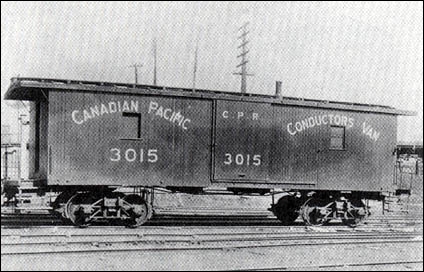Vol. 18 No. 2
February, 1988
|
Make Tomorrow Happen
|

Omer Lavallee
Corporate Historian
Emeritus
|

A Few Facts
on the History
of the
Caboose
|

Above is an early conductors' van, the forerunner of the familiar
caboose. The term "van" originated with the Grand Trunk Railway. Other names included "cabin
car", "saloon", "shanty car", and "way car".
I'd planned to discuss operating tourist railways in this issue's column, but
I've deferred that discussion until later in view of current interest in the history of the caboose.
Recently, the Railway Transport Committee of the Canadian Transport Commission gave Canada's two major railways
qualified approval to operate trains without cabooses. Cabooses would be replaced with End-of-Train
Information Systems (ETIS).
Announcement of this decision prompted a number of calls to me from the media. These included a couple of radio
interviews, seeking information about the history of the caboose.
CABOOSE ENTRENCHED IN RAILWAY LORE
The "little red caboose" behind the train is firmly entrenched in railway lore - so much so that there is
a general impression that such cars go back to the very beginnings of railroading on this continent 150 years ago.
In fact, they arrived on the scene much later, being adopted generally only in the late 1870s. Their appearance at
that time coincided with the beginnings of the organization of the railway labour force, and in response to demands
for better working conditions. However, isolated applications can be traced back to the
pre-Confederation period.
Until late in the 1850s, no crew cars were to be found on railways in Canada. The conductor and brakemen were
required to station themselves at different positions throughout the length of the train to apply and release hand
brakes in response to whistle signals from the locomotive. Train crews on passenger trains were sheltered, but
freight crews "decorating" the tops of freight cars were exposed to the elements while the train was in
motion.
THE FIRST FEW CARS
In inclement weather, when not required to be at the brakes, they took shelter by climbing into an empty boxcar.
During station stops, they could squeeze into the tight but relatively cosy confines of the locomotive cab, joining
the locomotive engineer and fireman.
The first crew cars in this country were introduced in 1859 when the Great Western Railway in Ontario, a Canadian
National ancestor, placed 33 10-ton, eight-wheeled "conductor cars" into service.
These units were followed, in 1860, by seven 8 1/2 ton "freight caboose cars", introduced by the Northern
Railway of Canada, another CN predecessor. These references appear in contemporary reports on the railways in Canada
prepared by Samuel Keefer between 1858 and 1860.
At the beginning of 1861, the Grand Trunk Railway of Canada - at 1,400 kilometres was not only the longest railway in
Canada, but also one of the longest in the world - possessed more than 200 locomotives and more than 3,100 cars - but
no crew cars.
However, by 1862, that line's Montreal shops were busy converting old four-wheeled boxcars into
British-style "brake vans", whose principal physical feature was a large brake wheel in the
middle of the floor. When applied, this brake caused the car to act as a "drag" and thus retard the train's
speed.
ORIGIN OF THE TERM VAN
These Grand Trunk cars originated the term "van", still widely-used in Canada for crew cars.
Other official terms used included "cabin car", "saloon", "shanty car", and "way
car".
By the time that what is now CP Rail was organized in 1881, the caboose had become a fixture on the railway scene.
The recent RTC ruling notwithstanding, cabooses will continue to be used in a few assignment categories.
Incidently, the word "caboose" is said to have been derived from the Dutch word used to describe small
structures mounted on the decks of sailing ships and used as kitchens or cookhouses.
This CP Rail News article is copyright
1988 by the Canadian Pacific Railway and is reprinted here with
their permission. All photographs, logos, and trademarks are the property of the Canadian Pacific Railway
Company.
|